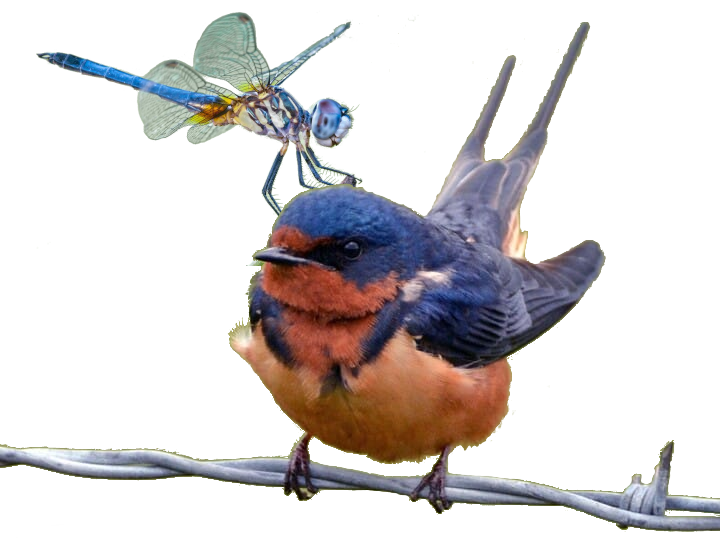In the world of ranching and cattle farming, pests like the horn fly (Haematobia irritans) can be a real thorn in the side—or more accurately, a bite on the hide. These tiny blood-sucking insects don’t just irritate cattle; they cause significant economic losses through reduced weight gain, lower milk production, and increased disease transmission. But what if I told you that nature has its own pest control squad? Enter the barn swallow and the dragonfly—two unlikely heroes that prey on these pesky flies without a drop of chemical intervention. In this blog, we’ll explore how these creatures work their magic, backed by science and real-world observations from farms and ranches.
The Horn Fly Menace: Why It Matters
Horn flies are small, grayish insects about half the size of a housefly, but their impact is outsized. They cluster on cattle’s backs, shoulders, and bellies, feeding up to 30 times a day on blood meals that can total over a pint per animal in severe infestations. This constant harassment leads to stressed cattle that spend more time swatting tails and stomping feet than grazing, resulting in weight losses of up to 15-20 pounds per animal during peak fly seasons.
To stay with our organic and regenerative goals, we don’t use insecticides and ear tags that come with drawbacks such as resistance buildup in flies and environmental issues. That’s where natural predators shine. By fostering habitats for barn swallows and dragonflies, ranchers can harness biological control—letting nature do the heavy lifting.
Barn Swallows: Aerial Acrobats Devouring Flies Mid-Flight
Barn swallows (Hirundo rustica) are graceful birds with iridescent blue backs, rusty throats, and deeply forked tails that make them look like tiny fighter jets zipping through the air. These migratory songbirds are voracious insectivores, and horn flies are right on their menu.
Foraging at heights where horn flies hover around cattle—barn swallows snatch insects on the wing with incredible precision. A single nesting pair, while raising their brood, can consume up to 7,000 flies per day! This includes flies, mosquitoes, and other small pests, making them incredibly valuable for natural insect control. Studies show that their presence in livestock sheds creates a “landscape of fear” for pest flies, reducing fly activity by intimidating them into hiding or fleeing.
On ranches, encouraging barn swallows is straightforward. We provide areas in barns and sheds to attract them during breeding season (spring through summer). Once barn swallows have established a nest, they return to it each year after their migration south. Ranchers who’ve welcomed these birds report fewer chemical treatments needed, making it a win for both cattle health and the environment.
Dragonflies: Fierce Insect Predators Patrolling the Skies
Dragonflies, often called “nature’s fighter jets,” are ancient insects with a predatory prowess that’s unmatched in the bug world. With four independently moving wings and eyes that provide nearly 360-degree vision, they boast a 95% success rate in capturing prey—far higher than most predators.
While they primarily hunt mosquitoes and midges, dragonflies readily prey on flies, including horn flies, by intercepting them in mid-air. In wetland-adjacent pastures or well-managed ranches with ponds and streams, dragonflies thrive and can significantly reduce fly populations around cattle. Land management, by maintaining water sources and avoiding overgrazing—can provide habitat for dragonflies and eliminate visible flies on cattle.
As apex insect predators, dragonflies don’t just eat adult flies; their nymphs (larval stage) in water bodies consume fly larvae, breaking the pest life cycle early. They’re particularly effective against biting flies like horn flies and tabanids (horse flies), which they snatch with basket-like legs formed by their spines.
The Synergistic Power: Birds and Bugs Teaming Up
What makes barn swallows and dragonflies even more effective is how they complement each other. Swallows patrol during the day, catching flies near cattle, while dragonflies add an extra layer of aerial defense, especially around water sources where flies breed. Together with other natural allies like dung beetles (which bury manure and disrupt fly breeding), they form a holistic pest management system. When insecticides are used they also harm beneficial insects like pollinators and natural predators, disrupting the balance of healthy ecosystems.
Tips for Ranchers: Inviting Nature’s Help
Ready to recruit these winged warriors? Here’s how:
For Barn Swallows: Provide ponds for nest-building, avoid pesticides that kill their food, and install artificial nests if necessary to get them started. Usually, if you provide the right environment the birds will naturally show up and thrive.
For Dragonflies: Maintain ponds, wetlands, or even small water features. Plant native vegetation to attract them and avoid draining breeding sites.
Monitor and Integrate: Combine with other methods like rotational grazing to enhance effectiveness.
Conclusion: Embracing Eco-Friendly Pest Control
In an era where regenerative ranching is a goal, turning to barn swallows and dragonflies for horn fly control isn’t just smart—it’s a return to nature’s balance. These creatures prove that sometimes the best solutions are the ones fluttering right overhead. If you’re a rancher dealing with fly woes, consider giving them a home; your cattle (and your wallet) will thank you.
What natural pest controls have you tried on your farm? Share in the comments below!

